Category: Longform
You are viewing all posts from this category, beginning with the most recent.
Biking and Cooking in Hanoi
Biking and Cooking in Hanoi
This will be my last post for a few days. Tomorrow we board a Junk on Halong Bay, and I’m certain we will not have Internet for our two days at sea. The next day is a travel day to Cambodia, so I won’t have access for most of that day either.
When I initially requested that we include some biking days in Vietnam, I had the kind of biking I do back home in mind. Road bike by Trek, a nice smooth open road with rice paddies on one side, and Water Buffalo peacefully grazing on the other; sunny weather with no breeze and low humidity. Perfect right?
This fantasy only goes to show how little I knew about Vietnam. Here is a picture of me on today’s bike.

Not a trek, although in Vietnam this is a prized bicycle. You must be one of the top workers in order to obtain this bicycle according to our guide. Now, I’m going to call this a fixie. It had only one gear so that mostly qualifies. Although it does have handbrakes and I can coast, so that works against true fixie classification. The second thing you may have noticed is that it is woefully undersized for me. The seat posts in Vietnam do not allow for much adjustment for American height males. And the frame is similarly small. People in the market were literally laughing at the big american on the small bike as we rode by today.
All of this really makes me appreciate two things. One: bicycles are an important and prized mode of transportation here. We have seen thousands of people riding them to work and school each day, in big cities and small villages. Two: The importance of a bike that actually fits you.
Although we were not on nice trek road bikes, the scenery today was great.
After the bike ride, we had lunch at the home of Ms Qiy. She is a retired professor of Vietnamese culture at one of the universities in Hanoi. But now she lives in her family home outside of hanoi. Their family home goes back 21 generations! She lives in the home with her youngest brother, and his children. At the back of the home is a shrine where they worship all of their ancestors.
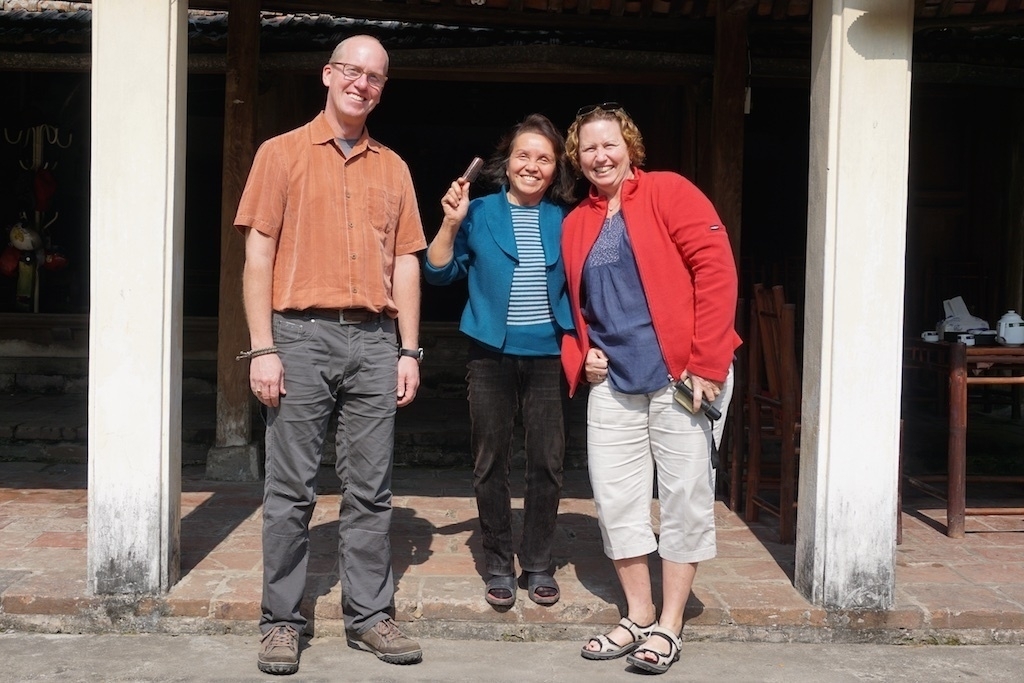
For Lunch we had fried spring rolls, some delicious pork wrapped in La Lota leaves, along with salad and rice vermicelli noodles. We got another nice lesson (and top secret recipe) for making spring rolls.

|
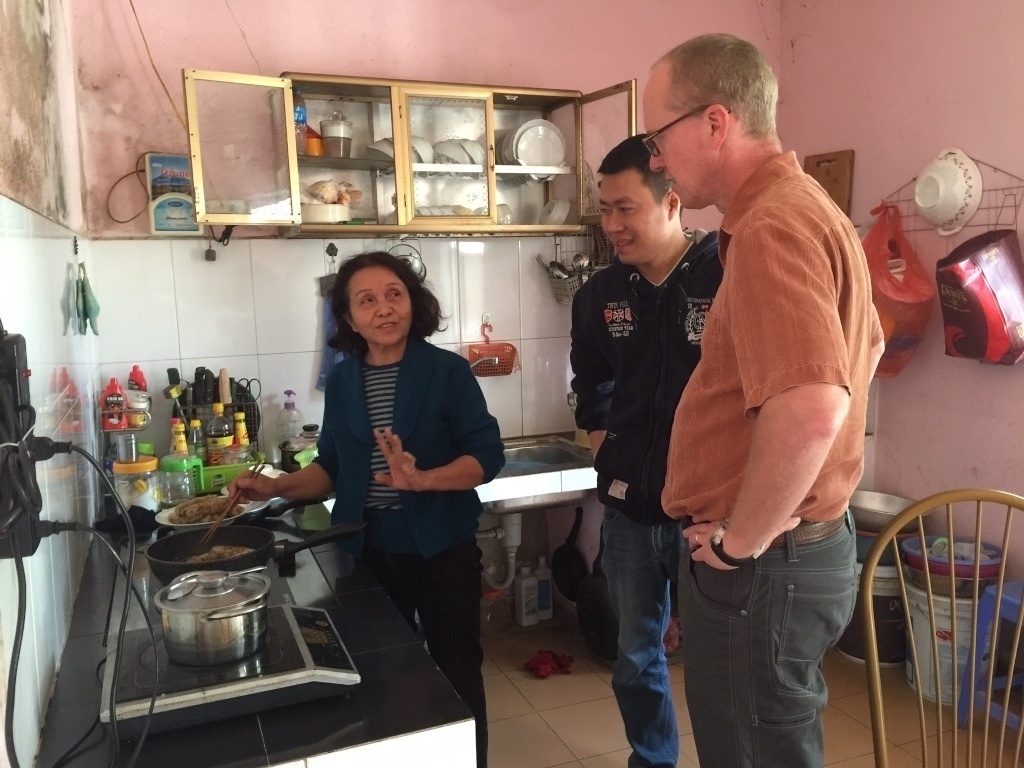
We were hoping to visit a primary school to speak english with some of the students but that did not work out as it is near the end of the year, and the principal and teachers had meetings that conflicted. On the other hand we were greeted by many school children as we left the village today. They all enjoy saying Hello to us, partly because we stick out so much, and partly because I think they want to see if we will respond. These two were especially cute as they chased us down the street on their bikes. Not only did we get a “hello” from them but also a “good afternoon.” When we stopped and asked them their names they became very shy.

Out of my Comfort Zone
Out of my Comfort Zone
The following post appears on the Luther College Ideas and Creations Blog
Saturday, 12:30 p.m.: Our guide told us the best way of visiting the war museum here in Saigon is to start on the third floor and work your way down. As we rounded the staircase onto the second floor we were met with the title for the main gallery on that floor: “War Crimes of America” Wow! I wasn’t expecting that. Suddenly I felt very uncomfortable. Throughout the museum we were confronted with images and stories of Agent Orange, senseless killings, Graphs depicting the numbers of bombs dropped on Vietnam in various years, and the use of Napalm. Clearly museums are not just dry exhibitions of facts, but can have their own point of view.
Sunday, 10:00 a.m.: Our first stop today is at a family run restaurant of the girl, Kim Phuc, she is widely known as “The girl in the picture” A pulitzer prize winning photo that many say galvanized the antiwar movement in the United States. It is a haunting photo, and the rest of her story is very moving. It is not easy to hear, it is even more difficult to imagine that our country would do that to a child.

Sunday, 1:00 p.m.: Our final stop of the day is at the Cu Chi tunnels where we meet a Viet Cong veteran, and watch a 1967 documentary that extolls the virtues of the “war heroes” who killed many americans, and destroyed many American Tanks. We learn about the cleverness and the bravery of the Viet Cong who set booby traps to kill the Americans, and lived in the tunnels of Cu Chi for years.
Monday, 4 a.m.: I awoke with a start, my heart was pounding, and my thoughts were already on the day ahead. Today was a biking day in the Mekong Delta, but tonight was our “home stay” night. I was a little panicked. Our guide had informed us last night that there would be no hot water and no air conditioning at our home stay. The high today would be over 90 degrees, and the humidity about what you would expect in the Jungle. We saw a lot of houses that I would not want to stay in the previous day. I think to myself, “Is there any way to get out of this? Why would I want to do a home stay when I am in this really nice hotel?”
Tuesday, 1:30PM: Our guide invites me to turn around, so that he can drape a Python over my shoulders. I have a lifelong fear of snakes, and as you can see, this is a big one. However, since I teach a programming language by the same name, and I know that many of my first year students struggle with the language, it somehow seems appropriate for me to over come that fear, and so the snake goes around my shoulders.
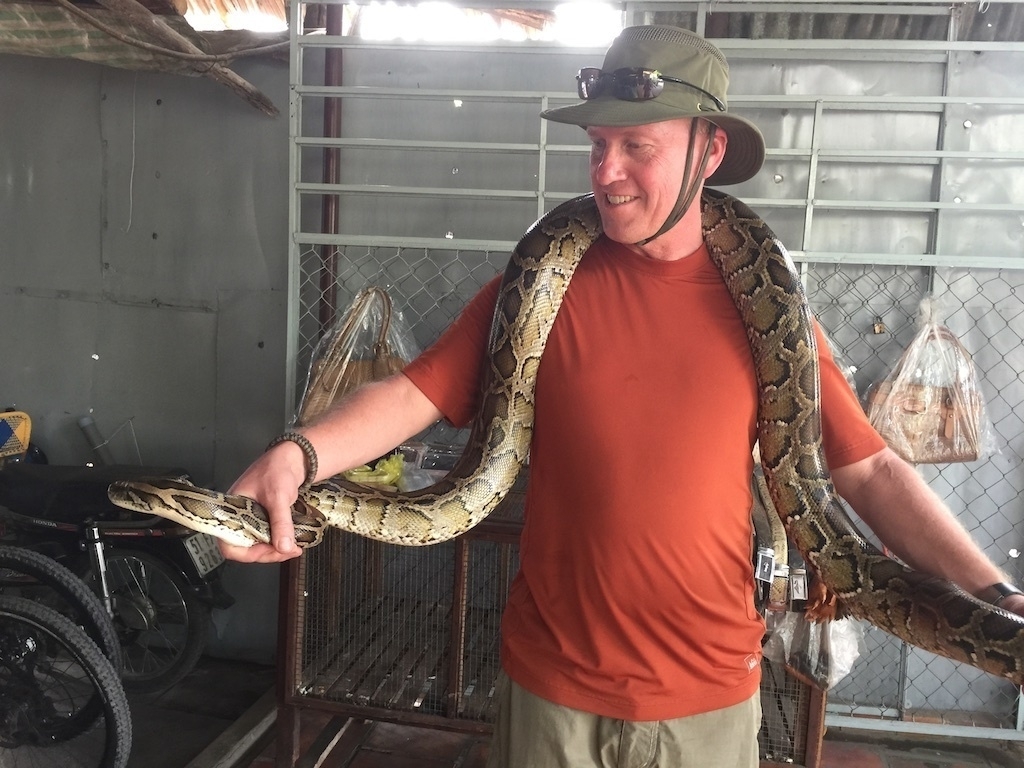
When my wife Jane and I told people we were going to Vietnam, we saw many different reactions: confused, worried, envious, and even peevishness. The mention of this country is capable of invoking a wide variety of emotions in people. I guess that is inevitable; there is the ghost of the war, and many have friends and family who died here. For some Vietnam is too far away, we are 13 hours ahead of Decorah and Luther College time. Politics: along with China and Cuba Vietnam is one of the few remaining communist countries. So why did we decide to go here?
Gereon Kopf recently posted about being uncomfortable. I agree with him that “stepping outside your comfort zone” is a good thing. It is a thing that we ask our students to do regularly, and so as a faculty member I think it is something we ought to ask of ourselves as well. One good way for me to do this is through traveling and experiencing new cultures and new points of view. Southeast Asia has long been on our travel bucket list, and since we will be directing the Malta program for Luther this Spring we decided that going to Malta the long way around, with a stop in Vietnam was a good way to extend our travels.
The vignettes at the start of this post illustrate several ways in which I have been pushed out of my comfort zone in only the first few days of our trip. Now the difficulty for me is that I am a problem solver by nature. Accusations of war crimes, pictures of young girls bombed with Napalm, comments from relatives that imply that our being here “on vacation” is somehow disrespectful to those who lost their lives in this country, and Pythons all cry out to be solved in some way. but there is nothing here I can solve, nothing really to fix. The things that are making me uncomfortable have largely happened in the past. There is nothing to do.
My own feelings about the war are not defined by personal experience. I was born after the US entered the conflict, and was only in kindergarten at the height of the bombing in 1969. I have no father or uncle or cousin who fought in the war. It wasn’t a topic that was covered in U.S. History classes when I was in High School, until now, most of my knowledge of the war came from Hollywood.
This morning we had an interesting conversation with our guide. We asked her what they teach about the American war in school. She told us, “we teach that you are bad.” She told us that she used to be a math teacher, from a communist family. But then she married a non-communist from the south. She was blacklisted, and so her prospects as a teacher were at an end. Her husband’s father abandoned his family and fled the country right after the war, becoming one of the many “boat people.” She told us that she knows that we are not bad people. She encouraged us to tell our friends to visit. This seems to be true of nearly everyone else we have had contact with. As a guide she has taken many American veterans back to their former battlefields, and she told us how they are all so grateful to see that Vietnam has healed and progressed as a country. It was a wonderful conversation.

Tuesday, 6:30 AM: I am sitting under a thatched roof, at the edge of the river, enjoying the sunrise, listening to the Roosters crow, as they have done for the last two hours. Our home stay turned out to be a rather pleasant visit. I got to make fried Spring rolls in the kitchen with our hosts last night, and although the mattress was a bit hard and our room a bit stuffy we slept. The beautiful sunrise reminds me that everything is alright. More than alright, I am lucky to be here, lucky to have this experience that gives me a new perspective on our world. The challenge for me going forward, as it is for all Luther students, is how I will live out this new perspective in the days and years to come.
The DMZ Bar
The DMZ Bar
Dear British Lady in the pink denim shirt:
Thanks for an entertaining evening of dining. I’m just sorry it had to come at the expense of that nice young assistant manager you abused for the better part of thirty minutes. What was it about the graffiti filled walls and sticky menu pages that made you think you were in for a fine dining experience?
After a day of visiting the Imperial City and the Tomb of Ming Minh we were in the mood for a drink and a pizza. You ordered some vegetables on rice. You were looking for vegetables that were steamed to preserve their color, yet mushy in texture. I hope you are continuing on to Hoi An. I would be happy to recommend a good cooking school. First you sent the vegetables back. Then you sent the rice back to be sure it would stay hot. Then you sent the vegetables back again.
After some debate you decided they were not capable of cooking your vegetables how you wanted them. I’m pretty sure that at this place the vegetables are microwaved. So, you ordered something and mashed potatoes. This was also returned to the kitchen. The look on the poor boy’s face when he brought you your third choice was one of pure fright. He clearly could not imagine that there was any scenario in which you would enjoy your food and honestly I think he was afraid you would grab him by the neck and shake him. I wanted to rush over and put my arm around him to let him know that he was not alone., that there were those of us around who would protect him should it come to violence over the quality of the carrots.
You then pulled aside another member of the waitstaff and gave him a lecture on the proper way to steam vegetables. I can only imagine that he immediately ran back to tell the chef what he (or she) had been doing wrong all this time.
Watching your husband during all of this was priceless. Clearly this is a story he has seen unfold many times. He and your son calmly ate what was brought to them, enjoying their meal and a beer. They were, of course, long done before you had something you were willing to eat. So they patiently waited while you ate.
I almost fell out of my seat when the waiter timidly asked if you would like desert. I’m pretty sure there was nothing he wanted more than for you to simply vanish. Sadly you refused desert, and so our show came to an end.
Have you learned nothing while visiting this country?
Today we visited the Thien Mu pagoda and the tomb of Minh Mang. We travelled by boat on the perfume river. The boat was owned by a nice couple, with two young children. They live on their boat. It is not heated, there is no running water. It is typical of so many of the boats we have used for transportation here in Vietnam. It has a crank start engine. This is not uncommon for this class in Hue. The government tried to relocate them to low income housing, but most of them prefer their boats. So, after trying their apartment they have moved back to the boat!
The weather has been cold and rainy here in Hue, so it makes everything seem a bit oppressive.
One interesting story from the tomb, which covers acres of space is that the king’s body was brought in by a secret tunnel, and laid to rest in one of many many tunnels that were dug in preparation for the burial. After the body was left, the workers that carried the casket to its final resting place were beheaded to keep the final location a secret!
Hang Me
Hang Me
The name of our lunchtime restaurant today was Hang Me. “Do you know what that means in English?”, I asked our guide. “Hung Mee?” he replied with a questioning look on his face. No, I said in English we would pronounce that “Hang me!” He got it, and and mimicked tightening a noose around his neck. We had a good morning with our guide, Vu, he was a last minute stand-in, as our appointed guide had come down with a high fever.
Hang Me, is definitely not a place we would have wandered into on our own. It was the kind of local restaurant that was in the wrong place and looked a little too grungy from the outside for me to even go in. We ended up at Hang Me because our guide had asked us whether we would like to go to a tourist restaurant or whether we would like to try some good local food. It may have been a bit of a leading question put that way, but we opted for the local food, he had earned our trust so far today. The local specialties include Banh Beo, Bahn Nam, Tom Cha, and Bahn Ram it. Need I say more? All of these were variations on a dumpling like theme. A rice flour mixture with prawn and or pork. They were OK, but in the end they all kind of blended together in a gooey-rice-mixture-with-prawns kind of way.

The Thien Vien Truc Lam Bach Ma Pagoda
We worked up our appetite by climbing 173 stairs to the Thien Vien Truc Lam Bach Ma Pagoda. At this point in the trip it might be easy to say that we are “pagodaed out.” But, that is not the case today. It was a bit of a journey to get there but it was well worth the trip. This Pagoda is set on an island in the middle of a quiet lake surrounded by high hills (they actually call them mountains here). After driving through the trees and countryside you arrive at a little parking area, from there you have to hike a bit more on foot before you come to the boat landing.
Since it is winter here, the water levels in the lake are a bit hight, and our boatman made the suggestion that we wade a bit to get to his boat. But our guide quickly convinces him that is not going to happen. So we do a little balancing act on a 2x6 to get on the boat and he pushes off. He starts the boat with a hand crank. The motor has two settings, forward and stop. The throttle is controlled by a string.
When we arrive at the island we disembark and hike up to the pagoda and monastery area. It is just beautiful. Aside from the two buildings, one for chanting and one for meditating, the setting is just unreal. We wish it wasn’t raining, because the colors must be incredibly vibrant in the sunlight. Even so, we feel like we could be on a movie set for some jungle adventure. The whole time we are there are only see two other people which just adds to the experience.
A Postscript about Football
Not American football, English football. Its amazing to me what a global league the English Premier League is. Here I am finishing up my blog post about today while watching Liverpool play Sunderland on TV at 9:00PM, the game started at 7:45PM. Of course back home this came would be the “early” game at 6:45AM. We have struck up conversations with most of the hotel bar staff as well as the bellman, it was the bellman who knew how to get the lobby TV to the right channel. Our guide today knew the names of every member of the Arsenal Invincibles as well as all the current members of Manchester United.
The Red Bridge Cooking School
The Red Bridge Cooking School
One of the things I have been anticipating the most on this trip is to take some cooking classes. Today was our first official lesson, at the Red Bridge Cooking School.

Our day started out with a tour of the market, which was nothing new, except that this time we were guided around by Chef Luna. For the tour we were put into groups of four. We met a very nice couple from Southampton England and had great conversation with them all day. Phil and Jane. It even turns out that her maiden name was Jane Miller, so what are the odds of that?
After the market tour we took a boat ride out to the restaurant and cooking school, and had another brief tour of their herb garden. We are getting lots of ideas for things to plant in our own garden next summer that we hope will grow in the Iowa summer.

Then its time for the real lessons to begin. We each get a clipboard with seven pages of recipes! Luna demonstrates how to make our first course. This is a rice flour pancake with shrimp and pork and green onion. When its done we wrap it up in some rice paper with herbs and salad. Then you make a quick dipping sauce to accompany the rolls. After the demonstration we are told to leave our recipes at our seats and to find a station. Now it is time to cook!
Here I am getting ready to make my pancake.

I’m really getting in a lot of healthy eating this trip. You just can’t avoid adding in all of the delicious vegetables to your dishes, and I have to admit they really do taste good. Who knows, this could be the start of a whole new relationship with vegetables for me.

The pattern set in the first recipe was repeated several times. Our full menu includes:
- Seafood Salad served in a Pineapple boat
- Fresh rice paper rolls of shrimp. Yes we learned how to make our own rice paper!
- Vietnamese Eggplan in clay pot. I can’t believe I ate eggplant and actually liked it.
- Steamed ocean fish on a bed of fresh vegetables.
It was so fun to make everything, and we can’t wait to recreate this cooking school experience for our friends back home.
The Flood Gates of Hoi An
The Flood Gates of Hoi An
Throughout all our time so far we have refrained from buying anything, at the markets we have visited, despite the aggressive sales tactics of some of the owners. We kept telling ourselves “we are traveling light, everything fits in our carryon. We will not check any luggage.” Until today. The markets of Hoi An have won.
The crack in the dam came yesterday when we visited an art gallery full of beautifully embroidered works of art. Today, during our free time, we went back. There were three pieces that we really liked. We narrowed the field down to my second and third choices. From there we nearly flipped a coin to decide. We thought about shipping the entire thing, frame and all, since the frame prices were so reasonable, but in the end we decided to just take the cloth. The cloth is easy to transport and takes up very little space, and can be ironed when we get back home before we frame the piece.
After that little purchase we were hungry and decided to have lunch. One of the places our tour company recommended in Hoi An is called Streets. We had a fantastic lunch, and learned a bit about this interesting organization for helping street kids by giving them 18 months of housing, food, and training in hospitality and the culinary arts. A delicious meal from a great organization. So I bought their cookbook.
I love buying cookbooks. I love reading cookbooks. I am a cookbook collector. There is no better way to remember the culture of a place than to be recreate the food you ate while visiting. And besides, what could be easier to transport and lighter to add to your luggage than a full color cookbook?
There was only one problem. I DON’T HAVE ROOM FOR A COOKBOOK. So we did what any sane travelers would do. We bought some chopsticks, and little wooden things to rest your chopsticks on, and a box to hold all of our new chopsticks. In fairness, I have to say that the chopsticks are made from the wood of a Jackfruit tree. Jane’s new favorite fruit. Then Jane bought some Genie Jammy pants, and a scarf, and I bought a couple of leather bracelets. Accessorize, accessorize!
In an effort to stop the flow of new goods into our possession, we fled back to the shopping free zone that is our hotel. Sadly, we didn’t make it past the leather bag store, Tu Chi, that we were “just browsing” in yesterday.
The young lady that runs the shop recognized us, and probably had us pegged as easy marks. She had some help from a guy who I imagine is her distributor in Russia. He did a nice sales job on the size, and construction quality of the bags. The one I really liked was a bit too large to make it past persnickety airline gate agents, so they said they would make me one that conforms to all the rules. Out comes the leather, in great big bolts. Which leather would I like, how would I like the top to zip open? How would I like the straps to be constructed. There was some discussion, from our new Russian friend, of carrying 20 kilos of potatoes. Sounds good in theory, but that would be over the weight limit of most airlines. Nevertheless this custom bag thing is all very cool. I’ll update this post with the finished product tomorrow evening.

|
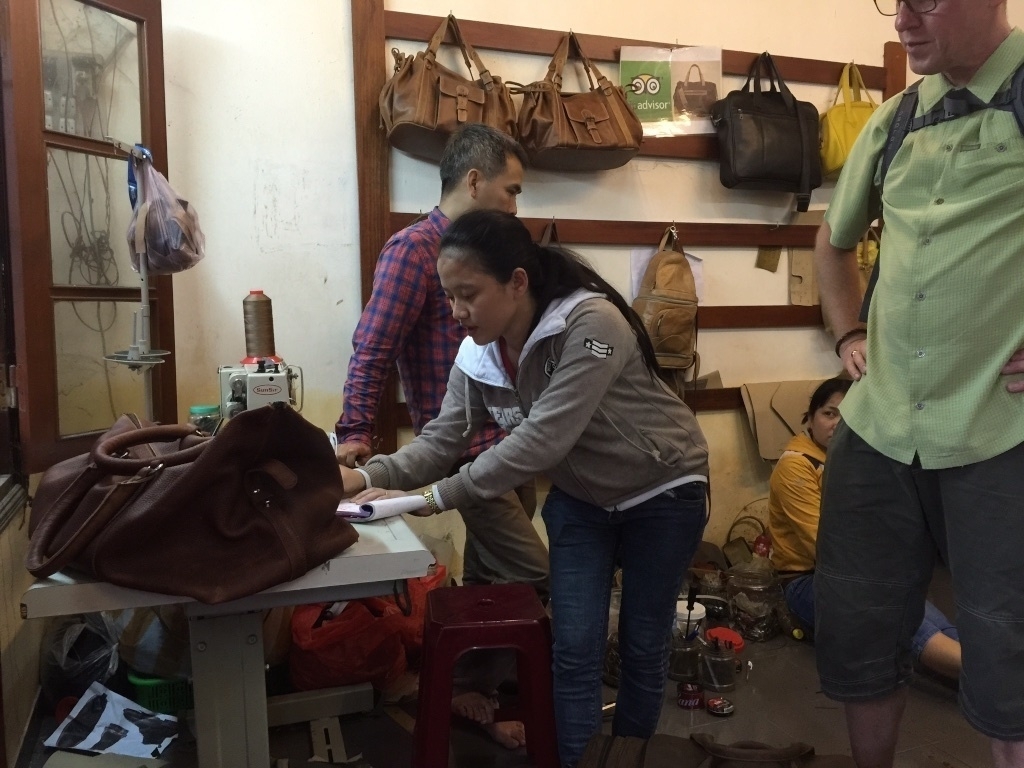
|
I guess we will be checking a bag for the flight to Hanoi after all.
Update: Here is a picture of the bag in progress, and the bag packed and ready for the airport in our hotel room in Hue.

|

To Market to Market
To Market to Market
It all started with motorbike parts. Our first day on the motorbikes, we went into the market. The first street we turned down was nothing but bits and pieces of motorbikes. After all, it takes a lot of parts to keep the millions of 20 year old motorbikes running. From there we saw everything from television remote controls, to hand wound springs, to big pieces of metal being cut with very hot torch-like things.
It progressed to the food market. A vast array of over 1000 stalls carrying everything from dried sea cucumber to sea monkeys to wood ear mushrooms to live eels to every imaginable spice to picked, well, everything.
Two days ago in the smaller neighborhood market in the Mekong delta, we witnessed women buying fresh frogs. They were alive, until the seller whipped out their kitchen shears and took care of the head and their horny little toes. How do you top fresh frog in the morning? Hmmm, how about a stop at the rat market? Rats not your thing? How about fresh snake? I asked Long if the rats were cheap thinking thats what the poorer folk ate. No, “very expensive” They are a delicacy. These are “good rats from the fields, not the rats from the market.” OK, I don’t think I really wanted to hear that.
We visited the floating markets of Cai Be, where you can buy sweet potatoes, bananas, fish, and crabs in massive quantities off of boats from all around Southeast Asia.
We have ridden our bikes past countless tiny markets, sandwiched between two houses in the countryside, selling soda, cigarettes, Pho, and Pringles. Yes, Pringles are surprisingly popular in the small neighborhood markets.
It is easy to resist buying food items from the markets because you know there is no chance that it is going to make it through customs at the next stop. So we look, we smell, we marvel at the variety. One Australian dude we overheard as we wandered through the food market yesterday pretty much summed it up: “F#ck I wish I could cook!”
Here are some photos that illustrate our trips through the market places of Saigon, the Mekong Delta, and now Hoi An.
Hoi An Nighttime
Hoi An Nighttime
After four days of non-stop activity, we took a short flight North to Hoi An. Hoi An, is a very much a vacation area for Vietnamese and foreigners alike. It is a World Heritage site and will provide us with some very welcome down time. Maybe more down time than we planned on since it is supposed to rain the next two days, and I don’t think we will do our bike ride if it is raining.

Long took us to the airport and escorted us through the checkin process and all the way to security where we bid him goodbye. It is really comforting traveling with a well trained guide in a country where you can barely say, hello and thank you. They make everything go smoothly. After a short flight to Danang, we were met by our guide Binh who will be with us for our time in Hoi An.
After checking in to the beautiful Ananantara Resort Hotel we went with Binh for some lunch and a walking tour of the old city. This is definitely a shopping destination, and I have a feeling we will be buying (and shipping home) some embroidered artwork. It is so finely done it is nearly photo realistic quality.
After resting up in our room we went out for a walk through the markets and shops at night. It is really beautiful here at night. The gallery below gives you a good idea of the colors here at night.
We totally enjoyed a long walk through the old town. After a while we stopped at a restaurant called the Seafood Garden. It didn’t look particularly great as a place to eat, and without a data plan we couldn’t just pop up trip advisor. Well we do have a data plan but it is ridiculously expensive (thanks Verizon), and it seemed obvious just by looking. (Update: TripAdvisor confirms our suspicions) But they had an upstairs balcony that we could sit at and have a drink and look out over the river. The drinks were cheap, and it was entertaining to watch the old gentleman who was waiting tables hustle tours from all of the other people around us for the next day.

We wanted to go back to the restaurant where we had lunch, as I think we spend a few days just happily working our way through the menu, however they were booked for the night. Who knew you needed reservations in this place. We ended up eating at the Hai Cafe where we had some nice Vietnamese barbecue. This is the restaurant where we will meet for our cooking class tomorrow.

The Meekong Delta
The Meekong Delta
The Meekong Delta
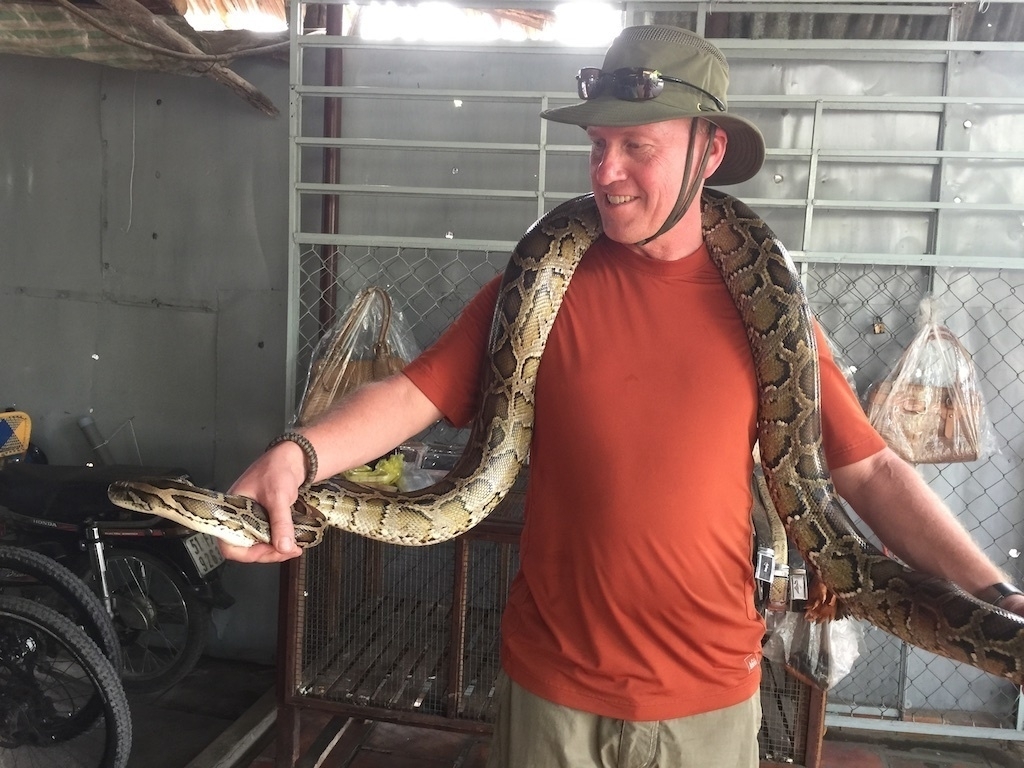
The picture pretty much sums up our experience here the last two days. We have both pushed ourselves outside our comfort zone, we have tried many new foods, and even took a sip of rice wine that had been marinating with cobra! Where do you go after a day like that?
Yesterday we left our hotel in the city and headed out to the Meekong Delta. This is an extremely fertile area where the Meekong river flows into the Sea. We started our day loading our bikes onto a boat and we headed up the river into the delta.

We made a stop along the way at a brick factory. It is such a step back in time, to visit a factory like this in Vietnam. We simply got off the boat and wandered around talking to a few of the workers. No badges required, no hard helmets, no insurance waivers. Its a pretty simple process, clay comes out of the river, and goes into a little hand operated machine that mikes the clay and extrudes the bricks. After drying on their own for a few weeks they eventually make it into a big kiln which is fired by rice husks.
We got off the boat, along with our bikes at another small factory, this time they were making all kinds of things out of coconuts. Coconut water, candy, coconut milk, shaved coconut. If it was possible to squeeze another product out of coconut they would find a way to do it. Before we set off on our bikes we had a whole plate of fruit to try. Including dipping your fresh pineapple into a mixture of salt and chile peppers -- delicious. I ate more fruit yesterday than I have in a year. Which isn’t saying much good about my diet, I know.
After an hour or so of biking through the tiny backroads of the delta we stopped for lunch. A great outdoor restaurant that basically appeared out of nowhere. One minute we were biking through the trees and the next we were pulling into a “neighborhood restaurant.” Our first course was fried spring rolls. Love em. Our second consisted of a whole Elephant Ear fish, fried and presented standup style for us. For you aquarium keepers this is also known as a Giant Gourami. I’ve had gouramis in my aquarium before, but I never thought I’d eat one. Anyway, we learned how to eat this by rolling the fish, along with some rice noodles and some pineapple and cucumber and mint, and basil in rice paper. The third course was a noodle soup which also had two giant prawns for us to try. Then came a course which consisted of a bowl of rice and some chicken curry. Of course by this time we were totally stuffed, and leaving all kinds of food on the table. So of course they have to bring dessert. Well, more fruit at least.
I honestly do not know how all of the vietnamese people stay so healthy and slim. From what I have observed in the last three days they eat insane quantities of food.
After lunch we do a bunch more biking, and then end up at our “homestay” house. This was the part of the trip that had me the most nervous. Honestly, I like my nice hotels, I’m really more of an introvert when it comes to meeting new people, so showing up at someone’s house in the middle of the delta, knowing in advance that the house did not have air conditioning, internet, or hot water seemed like a bad idea. But it all worked out.

One of the great highlights of the evening was our spring roll lesson. Yep, in a real Vietnamese kitchen I got to learn first hand how to make one of my all time favorite foods.

It was a pretty early night, and as it turned out pretty sleepless as well. We were hot, and our mattress was pretty hard, “softer than cement” according to Jane. So it was early to bed early to rise. We had a quick breakfast, and then biked to the local market. In the delta, locally grown is not a “movement,” it is a way of life, and has been for years. The pork that is sold fresh at the market was butchered just hours ago, and it will all be consumed before the day is out. Fish, eel, frogs, etc. are all still alive and swimming when you get there, when you pick out what you want they will fillet them for you. It was all caught today, and it will all be eaten today. The produce is a similar story with more kinds of fruits and vegetables available than I can even think about.
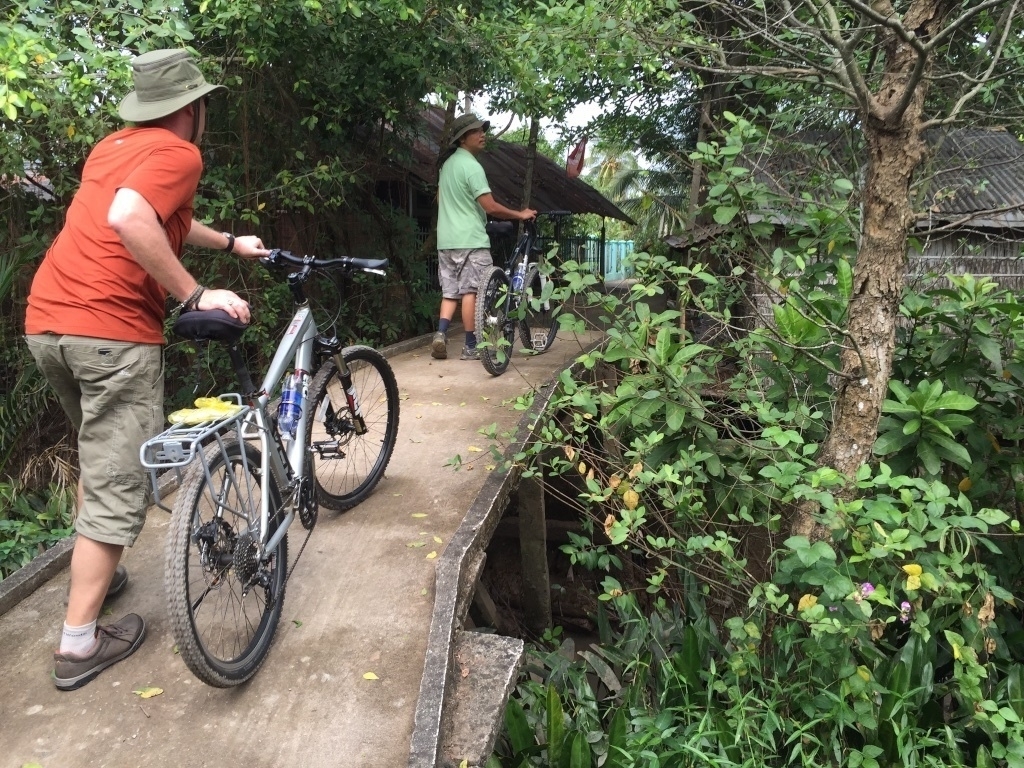
After the local market we meet up with our driver again, and we head somewhere else on the delta to visit the Cai Be floating market. This is similar to the local market but here things come, by boat, from further away. Each boat sells its specialty, and you can tell what they are selling because they have it flying from a flagpole on the boat!
Here is where things take a turn for the weird. It seems that Long has decided we need to be challenged. So after we get off the boat and bike for a few feet, he stops and says he wants to show us “how they make honey” OK, fine we get to see a beehive, but thats not enough, as he wants me to hold it. There must be a thousand bees on this thing and he wants me to just stay calm and hold the thing.
That turned out to be easy compared to the next lesson: a big jar, whats in the jar? Looks like snakes to me. Gross. Have I mentioned my lifelong fear of snakes? OK, so its a jar full of rice wine and snakes. Lets see what kind of snake? Oooooh a Cobra, glad its dead and pickled. Glad he didn’t tell me they were lurking around on the delta until now. Lets have a toast shall we? Um, really? you want me to drink rice wine that has been marinating a dead cobra? Fine. Well, it mostly tasted like strong rice wine, but apparently I’m going to be stronger tomorrow. Yes, just in case you were wondering, they do have a similar variety featuring a scorpion.
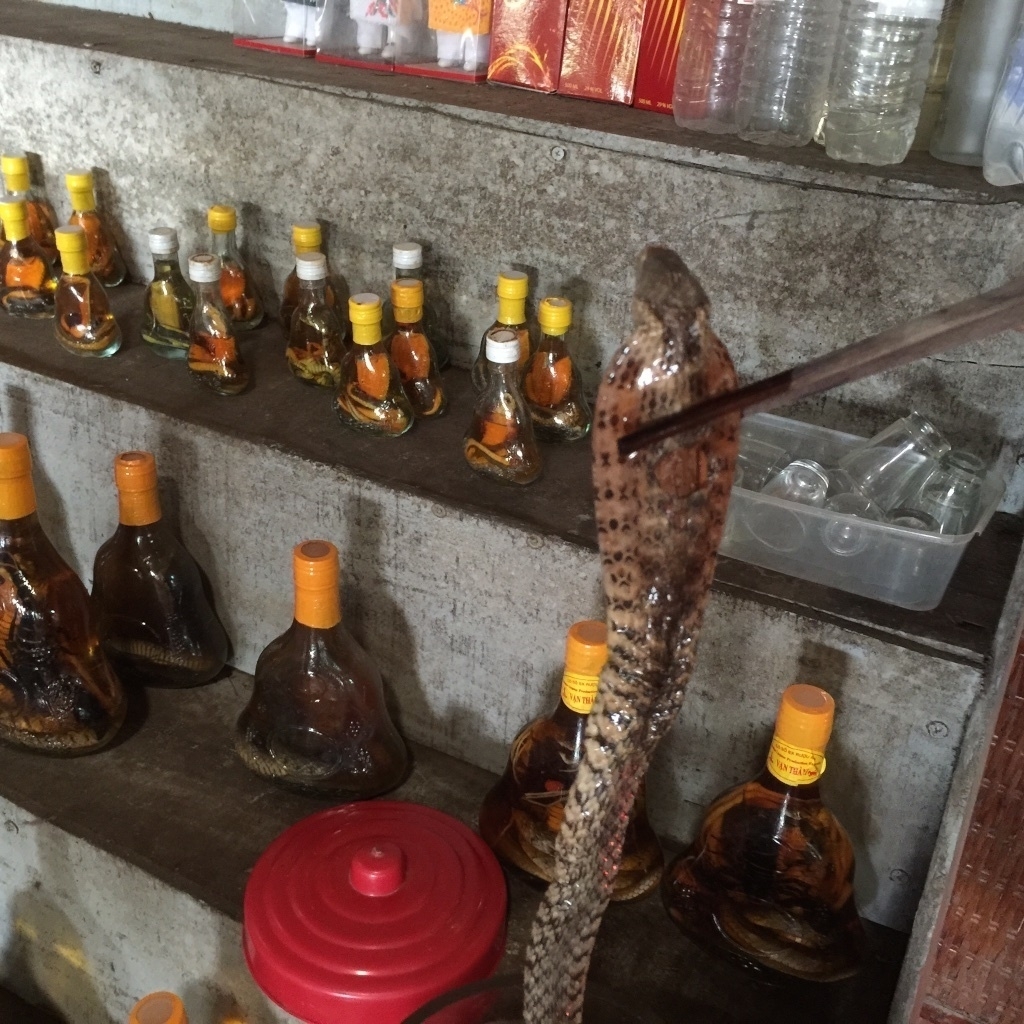
Which brings us to the giant Python. After pulling it out of its cage, and informing us that it is not poisonous, but does bite. He says, ok Brad, your turn. Really! I can assure you that holding a giant Python has never been on my list of things I want to try. I can also assure you that I had not consumed enough rice wine and cobra to give me the courage to do this. But, something deep inside me said, if you are going to teach Python you ought to have a picture of yourself holding a giant one. So there you have it. More on the Meekong Delta later.
My Life as a Tunnel Rat
My Life as a Tunnel Rat
For Sale: Spacious multi-bedroom dwelling, Over 150,000 square kilometers. three levels, the lowest will withstand even the heaviest B-52 bombing. Includes meeting rooms and hospitals. Miles of short narrow corridors, ideal for hobbits. Secret underwater entrance.
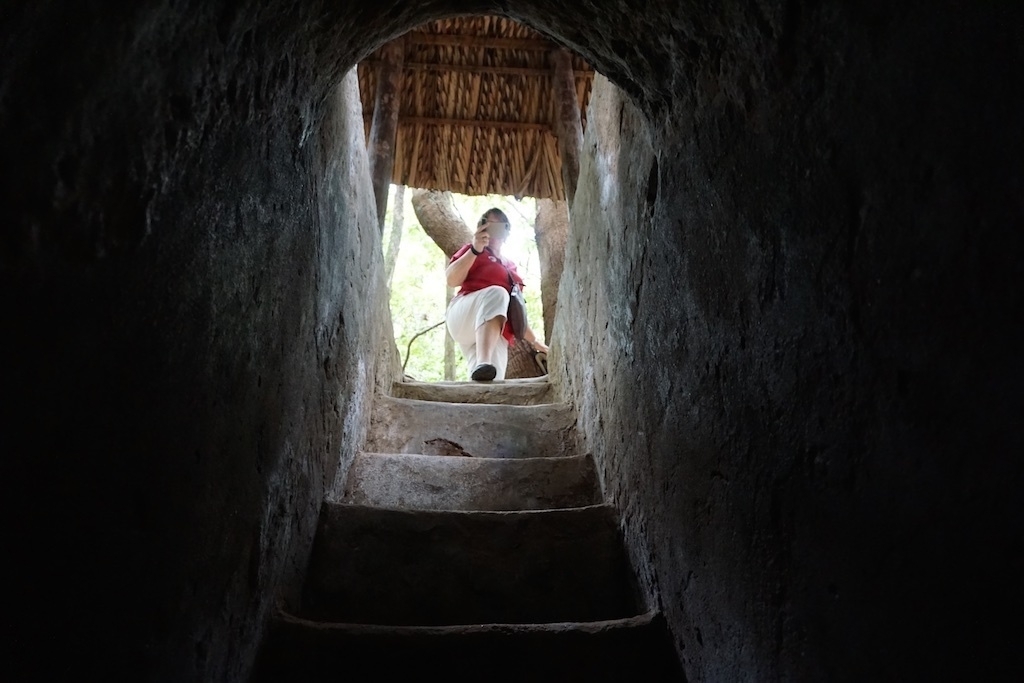
How would you like to live for nine years in an underground house? Yesterday we met Mr. Nam, who did just that. Mr. Nam fought for the Viet Cong. First against the French, then against the Americans. The Cu Chi area is now a park where you can learn about the Viet Cong, including a very one-sided video produced in 1967.
Then you can actually tour the tunnels. In the gallery below you can see me entering the tunnel through one of the many hidden entrances. I emerge again a few minutes later at another hidden entrance about 20 feet away from the first. At 6 feet tall I am definitely not built for climbing around in these tunnels.
The whole Cu Chi area really gave you a good sense for what the jungle was like. Bamboo trees, vines, paths through the trees, lots of overgrown bomb craters. The only thing missing from the war movies (thankfully!) was pounding rain.
Here are links to a couple of videos Jane took of me getting into and leaving the tunnel.